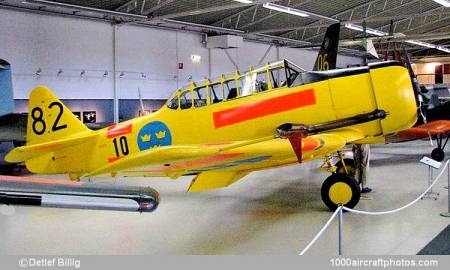12/31/2012. In August 1938 Noorduyn Aviation of Montreal, Quebec, Canada, bought the manufacturing rights for the North American AT-16 advanced trainer. At that time Britain and France were seeking suitable American aircraft to counter the German threat. Robert Noorduyn said he did not know what Service aircraft they might choose but thought they must choose the North American trainer. His perception can be appreciated by the fact that Noorduyn was to build 2,800 Harvard versions, as the RAF named the type, and Canadian Car & Foundry built a further 555 after the war, to make it the most numerous type ever built in Canada.
It was not until January 18, 1940, that Noorduyn received its first order, for 100 RCAF machines, followed by another for 110 in September, and then the RAF orders. The first 1,500 RAF Harvards were paid for by the United States under the Lease-Lend Act. Noorduyn's facilities were not large enough to handle the contracts so an immediate expansion took place at Cartierville, where final assembly took place, and a new plant was leased at Longue Pointe where manufacturing was concentrated.
The Harvard IIB, USAAF designation AT-16, produced in Canada was like the US-made Harvard II except for improved cockpit heating and other minor changes. The Harvard was intended to train graduates from the elementary flying schools up to the point where they could fly single-engine Service aircraft, and it was fitted with a controllable-pitch propeller, retractable landing gear and flaps. It could be armed with a machine gun in the wing for gunnery practice.
The Harvard's wing, fixed tail plane and fin were of stressed-skin construction and the control surfaces had a fabric covered metal structure. The rear fuselage was of stressed-skin construction while the front portion had a welded steel-tube structure enclosed by metal panels. The Noorduyn prototype, RCAF 3034, was completed on January 18, 1941, one year from the date of the contract. It was tested at Cartierville by E.L. Capreol and accepted by the RCAF at Rockcliffe on January 31.
Noorduyn-built Harvards in use by the RCAF included 639 RAF aircraft in the FE, FH, FS and FT ranges of serials which continued to serve with their original numbers. These Harvards, along with some US-built machines, were used for all single-engine advanced training in Canada during the war and some continued in RCAF service until 1960. Some were converted by the RCAF into wireless trainers.
Many of the RAF Harvard IIBs were transferred to the air forces of Australia, India and New Zealand. One aircraft, FE395, was taken over by the USAAF in India and used under its lend-lease serial 42-692, and there may have been others. There were minor differences between Harvards supplied to the RAF and the RCAF. Instrumentation was slightly different and the RCAF had the rear navigation light on the rudder while the RAF had it on each side of the fin. The RCAF had an upward identification light but the RAF did not. One AT-16 only was delivered to the USAAF by Noorduyn, believed to have been RAF FE267/USAAF 42-11487.
Many RCAF surplus Harvards were put up for sale, including the pictured aircraft. Destined for the MAP, it was built under the USAAF serial 42-829, and assigned to the RAF under the British serial FE632. However, it was delivered to the RCAF on November 14, 1942 and served for four years in Canada till it was struck off charge on December 11, 1946. The Charles Babb Co. of Montreal had acquired the aircraft and sold it the same month to the Swedish AF, which allotted the designation Sk 16A and the serial 16109. After being struck off charge it went to the Flygvapenmuseum at Malmslatt AB, Sweden, in 1975 and is since on display.
